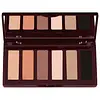r.e.m. beauty Midnight Shadows Eyeshadow Palette Versus Charlotte Tilbury Super Nudes Easy Eyeshadow Palette
What's inside
What's inside
 Key Ingredients
Key Ingredients

 Benefits
Benefits

No benefits
 Concerns
Concerns

 Ingredients Side-by-side
Ingredients Side-by-side

Egg
Skin ConditioningZinc Stearate
Cosmetic ColorantSilica
AbrasiveCaprylic/Capric Triglyceride
MaskingCaprylyl Glycol
EmollientEthylhexylglycerin
Skin ConditioningTriethoxycaprylylsilane
Squalane
EmollientCI 77891
Cosmetic ColorantIron Oxides
CI 77742
Cosmetic ColorantCI 77007
Cosmetic ColorantMica
Cosmetic ColorantCalcium Sodium Borosilicate
Synthetic Fluorphlogopite
Hydrogenated Styrene/Isoprene Copolymer
Pentaerythrityl Tetra-Di-T-Butyl Hydroxyhydrocinnamate
AntioxidantCI 77000
Cosmetic ColorantCalcium Aluminum Borosilicate
Indigofera Tinctoria Extract
MaskingTin Oxide
AbrasiveCI 77510
Cosmetic ColorantEgg, Zinc Stearate, Silica, Caprylic/Capric Triglyceride, Caprylyl Glycol, Ethylhexylglycerin, Triethoxycaprylylsilane, Squalane, CI 77891, Iron Oxides, CI 77742, CI 77007, Mica, Calcium Sodium Borosilicate, Synthetic Fluorphlogopite, Hydrogenated Styrene/Isoprene Copolymer, Pentaerythrityl Tetra-Di-T-Butyl Hydroxyhydrocinnamate, CI 77000, Calcium Aluminum Borosilicate, Indigofera Tinctoria Extract, Tin Oxide, CI 77510
Synthetic Fluorphlogopite
Dimethicone
EmollientMica
Cosmetic ColorantOctyldodecanol
EmollientHdi/Trimethylol Hexyllactone Crosspolymer
Trimethylsiloxysilicate
EmollientDimethicone/Vinyl Dimethicone Crosspolymer
Skin ConditioningSilica
AbrasiveCaprylyl Glycol
EmollientEthylhexylglycerin
Skin ConditioningCI 77891
Cosmetic ColorantIron Oxides
CI 19140
Cosmetic ColorantCI 75470
Cosmetic ColorantCI 77007
Cosmetic ColorantC30-45 Alkyl Dimethicone
Skin ConditioningSorbitan Isostearate
EmulsifyingC20-24 Alkyl Dimethicone
Skin ConditioningPolyglyceryl-2 Tetraisostearate
EmollientCI 77120
Cosmetic ColorantCalcium Aluminum Borosilicate
Calcium Sodium Borosilicate
Tin Oxide
AbrasiveCI 77499
Cosmetic ColorantSynthetic Fluorphlogopite, Dimethicone, Mica, Octyldodecanol, Hdi/Trimethylol Hexyllactone Crosspolymer, Trimethylsiloxysilicate, Dimethicone/Vinyl Dimethicone Crosspolymer, Silica, Caprylyl Glycol, Ethylhexylglycerin, CI 77891, Iron Oxides, CI 19140, CI 75470, CI 77007, C30-45 Alkyl Dimethicone, Sorbitan Isostearate, C20-24 Alkyl Dimethicone, Polyglyceryl-2 Tetraisostearate, CI 77120, Calcium Aluminum Borosilicate, Calcium Sodium Borosilicate, Tin Oxide, CI 77499
Ingredients Explained
These ingredients are found in both products.
Ingredients higher up in an ingredient list are typically present in a larger amount.
Calcium Aluminum Borosilicate is made up of calcium, aluminum, and silicates. It is a glass-like material. In cosmetics, it comes in the form of flakes or microspheres.
Calcium aluminum borosilicate is a bulking agent, meaning it helps thicken a product.
This ingredient is created by slowly mixing several minerals, including kaolin clay.
Although “aluminum” in an ingredient name can raise red flags for some consumers, the form and usage context matter significantly. For typical topical applications, there is no substantial evidence of health risks - such as cancer, neurotoxicity, or systemic “aluminum overload.”
Learn more about Calcium Aluminum BorosilicateCalcium Sodium Borosilicate is a bulking agent. It is considered a borosilicate glass; it is composed of powder or flakes of calcium and sodium borosilicates.
This ingredient is used to add volume, shine, and color to products. You'll most likely find this ingredient in makeup products.
According to in-vivo and ex-vivo studies done by a manufacturer, this ingredient works well with UV filters:
Learn more about Calcium Sodium BorosilicateCaprylyl Glycol is a humectant and emollient, meaning it attracts and preserves moisture.
It is a common ingredient in many products, especially those designed to hydrate skin. The primary benefits are retaining moisture, skin softening, and promoting a healthy skin barrier.
Though Caprylyl Glycol is an alcohol derived from fatty acids, it is not the kind that can dry out skin.
This ingredient is also used as a preservative to extend the life of products. It has slight antimicrobial properties.
Learn more about Caprylyl GlycolThis pigment is called Ultramarine blue lazurite. It gives a saturated blue color, but can be used to create other colors as well.
According to the manufacturer, it is usually made from kaolin, sodium sulfate, sodium carbonate, sulfur, and charcoal.
Ci 77891 is a white pigment from Titanium dioxide. It is naturally found in minerals such as rutile and ilmenite.
It's main function is to add a white color to cosmetics. It can also be mixed with other colors to create different shades.
Ci 77891 is commonly found in sunscreens due to its ability to block UV rays.
Learn more about CI 77891Ethylhexylglycerin (we can't pronounce this either) is commonly used as a preservative and skin softener. It is derived from glyceryl.
You might see Ethylhexylglycerin often paired with other preservatives such as phenoxyethanol. Ethylhexylglycerin has been found to increase the effectiveness of these other preservatives.
Mica is a naturally occurring mineral used to add shimmer and color in cosmetics. It can also help improve the texture of a product or give it an opaque, white/silver color.
Serecite is the name for very fine but ragged grains of mica.
This ingredient is often coated with metal oxides like titanium dioxide. Trace amounts of heavy metals may be found in mica, but these metals are not harmful in our personal products.
Mica has been used since prehistoric times throughout the world. Ancient Egyptian, Indian, Greek, Roman, Aztec, and Chinese civilizations have used mica.
Learn more about MicaSilica, also known as silicon dioxide, is a naturally occurring mineral. It is used as a fine, spherical, and porous powder in cosmetics.
Though it has exfoliant properties, the function of silica varies depending on the product.
The unique structure of silica enhances the spreadability and adds smoothness, making it a great texture enhancer.
It is also used as an active carrier, emulsifier, and mattifier due to its ability to absorb excess oil.
In some products, tiny microneedles called spicules are made from silica or hydrolyzed sponge. When you rub them in, they lightly polish away dead skin layers and enhance the penetration of active ingredients.
Learn more about SilicaSynthetic Fluorphlogopite is the synthethic version of mica. It consists of fluorine, aluminum and silicate.
Synthetic Fluorphlogopite is used to add volume to products.
It is considered non-irritating on the skin.
Learn more about Synthetic FluorphlogopiteTin Oxide is an inorganic oxide used to add opacity and volume to a product. In nature, it is already found in mineral form. The main ore of tin is an opaque and shiny mineral called casseterite.
Tin Oxide helps remove translucency in a product, or make it more opaque. Besides adding opacity, tin oxide is used for bulking to add volume.
This ingredient is a combination of red, black, and yellow iron oxide pigments. This combination of colors is usually found in foundation, because it results in a "skin" color.